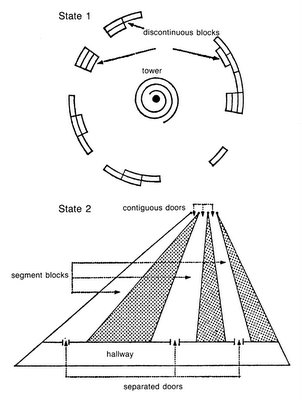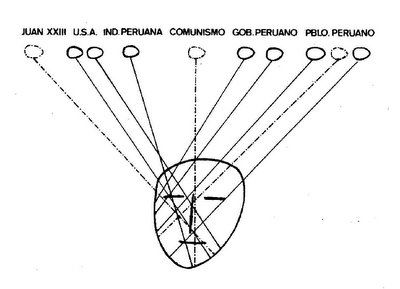First, Arguedas's El zorro de arriba y el zorro de abajo includes, as one element of its decidedly messy mixed-genre text, a diagram.
This comes in the same section that I've discussed already: as the factory manager, Don Angel, is showing his visitor, Diego, around the bowels of the machinic apparatus. Diego asks Don Angel "And the panorama? How do you see the panorama, the conjunction of things?" Angel replies:
Yes, Diego my friend; yes I see the panorama more clearly. Wait a moment. This is the way the conjunction is. That's it! Take a good look at this map or diagram, complete with names, that I'll trace and write down; I'll be drawing it. This is how it starts. Watch my hand and listen to my words. I think that something will come out of this; yes, something objective. Look...So we have ten eggs, and ten lines, which converge and cross over a face, a mask, that is the face of Peru. This is a diagram of power (is there any other kind?), a balance of forces, in which the industrialist expresses his confidence in the eternal omnipotence of capital.
Seven white eggs against three red ones. There's us, and industry, and the USA, the Peruvian government, the Peruvian people's ignorance, and the ignorance of the Cardozos [the liberation theology priests] about the Peruvian people, together we all make up the white forces. On the other hand, John XXIII, Communism, and the rage, whether lucid or cock-eyed, of a small section of the Peruvian people against the USA, industry, and the government, all these make up the red forces. Take a look: that's the face of Peru, that's it with its three little red lines. [. . .] In short, Diego my friend, we are seven white eggs against three red ones. And one of the red ones, Communism that is, has maggots infesting its dying body. I know what I'm talking about. And this map won't change ever at all against capital, only in its favour. It's a sure thing! There are just a few people in power through the whole universe, heaven and earth, water and sea. (92-93)
But if Diego is indeed "watch[ing his] hand and listen[ing] to [his] words" at the same time, as Don Angel encourages him to do, perhaps it might occur to him that the two are not necessarily consonant. Where does the factory manager come up with these seven blocks, for instance? And where are "we," the elite subject that he first invokes? Part of the Peruvian government, or part of the Peruvian people? What is the logic of the lines' criss-crossing and semi-convergence, also at times semi-divergence? Do these lines construct the face we see, or does that pre-exist the diagram? Is it indeed a face, or a mask, a fetish, set at a distance from all the elements of Peruvian society that are, after all, separated out at the top of the picture?
In other words, for all the narrative verve and confidence that Don Angel brings to his analysis of the social panorama, there's a sense in which the diagram betrays him. The lines of force that he traces take flight, obeying their own logic, suggesting their own conclusions--perhaps a more open future than the inevitable permanence of capitalist rule the manager himself so confidently predicts.
Meanwhile, there's at least a topological similarity between the diagram to be found in Arguedas's book and the two architectures of power outlined in Deleuze and Guattari's Kafka: Toward a Minor Literature.
These two diagrams designate two states of social architectonics, which are both distinct and commingling. The first of these is the image of transcendence, or the quasi-cause: rather than eggs we have blocks, set at a distance from a central tower in which power purports to reside. (There is of course something here of Foucault's analysis of the panopticon, though that's not directly referenced.)
This first state is governed by a logic of
the distant and the close [. . .] the blocks that form arches of the circle are close to each other--they join up by forming couples. It is also true that they remain distant from each other, since gaps that will never be filled remain between them. Furthermore, the transcendental law, the infinite tower, is infinitely distant from each block; and, at the same time, it is always very close and never ceases to send its messager to each block, bringing one near the other when it moves away from the other, and so on. The infinitely distant law emits hypostases, sends emanations that always come closer and closer. (76-77)

The second architectural state, on the other hand, is governed by a logic of the
faraway and the contiguous. Faraway is opposed to close, contiguous is opposed to distant. But in the grouping of the experiences and concepts, faraway is equally opposed to distant, contiguous opposed to close. In fact, the offices are very far away from each other because of the length of the hallway that separates them (they aren't very close), but they are contiguous because of the back doors that connect them along the same line (they aren't very distant). (77)Rhizome versus arborescence, in short--but also bureaucratic machine versus (myth of) sovereignty. And posthegemony versus hegemony.
To return to Arguedas, then, the task would be to seek out the other diagram, the rhizomatic diagram of the faraway and the contiguous that would start to undo and counter Don Angel's faith in the distant and the close.
As a first approximation, as I have suggested, we may find traces of that other diagram even in the map drawn by the factory manager himself. For is not the shape of his diagram closer to the second of Deleuze and Guattari's diagram (the posthegemonic assemblage) than the first: another triangle, another set of disjunctive convergences, albeit inverted? One step might then be to invert the industrialist's diagram, to put his account of Peruvian society, in which capital is necessarily in the driving seat, back on its feet.
And a second approximation would be to seek that other, missing diagram elsewhere in Arguedas's work. To open up the Arguedas-machine to the immanence of affective contiguity and intensity in the faraway highlands, to follow the set of procedures for achieving the plane of immanence that have governed his writing from the very start.

No comments:
Post a Comment